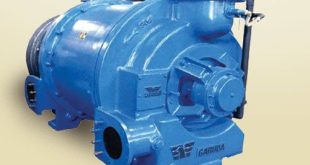How does a Roots blower work?
How does a Roots blower work?
The Roots supercharger is the oldest design. Philander and Francis Roots patented the design in 1860 as a machine that would help ventilate mine shafts. In 1900, Gottleib Daimler included a Roots supercharger in a car engine.
illustration of Roots supercharger
Roots supercharger
As the meshing lobes spin, air trapped in the pockets between the lobes is carried between the fill side and the discharge side. Large quantities of air move into the intake manifold and “stack up” to create positive pressure. For this reason, Roots superchargers are really nothing more than air blowers, and the term “blower” is still often used to describe all superchargers.
۱۹۴۰s Ford pickup with protruding Roots supercharger
Photo courtesy Sport Truck
A 1940s Ford pickup with a Roots supercharger.
Roots superchargers are usually large and sit on top of the engine. They are popular in muscle cars and hot rods because they stick out of the hood of the car. However, they are the least efficient supercharger for two reasons: They add more weight to the vehicle and they move air in discrete bursts instead of in a smooth and continuous flow.
[/av_textblock]